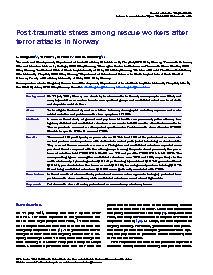Post-traumatic stress among rescue workers after terror attacks in Norway
BACKGROUND:
On 22 July 2011, Norway was struck by two terror attacks. Seventy-seven people were killed, and many injured. Rescue workers from five occupational groups and unaffiliated volunteers faced death and despair to assist victims.
AIMS:
To investigate the level of, and associations between, demographic variables, exposure and work-related variables and post-traumatic stress symptoms (PTSS).
METHODS:
A cross-sectional study of general and psychosocial health care personnel, police officers, firefighters, affiliated and unaffiliated volunteers were conducted ~10 months after the terror attacks. The respondents answered a self-reported questionnaire. Post-traumatic stress disorder (PTSD) Checklist - specific (PCL-S) assessed PTSS.
RESULTS:
There were 1790 participants; response rate was 61%. About 70% of the professional rescue workers had previous work experience with similar tasks or had participated in training or disaster drills. They assessed the rescue work as a success. Firefighters and unaffiliated volunteers reported more perceived threat compared with the other groups. Among the professional personnel, the prevalence of sub-threshold PTSD (PCL 35-49) was 2% and possible PTSD (PCL ≥ 50) 0.3%. The corresponding figures among the unaffiliated volunteers were 24% and 15%, respectively. In the multivariate analysis, female gender (β = 1.7), witnessing injured/dead (β = 2.0), perceived threat (β = 1.1), perceived obstruction in rescue work (β = 1.6), lower degree of previous training (β = -0. 9) and being unaffiliated volunteers (β = 8.3) were significantly associated with PTSS.
CONCLUSIONS:
In the aftermath of a terror attack, professional rescue workers appear to be largely protected from post-traumatic stress reactions, while unaffiliated volunteers seem to be at higher risk.
Geachte bezoeker,
De informatie die u nu opvraagt, kan door psychotraumanet niet aan u worden getoond. Dit kan verschillende redenen hebben,
waarvan (bescherming van het) auteursrecht de meeste voorkomende is. Wanneer het mogelijk is om u door te verwijzen naar de bron
van deze informatie, dan ziet u hier onder een link naar die plek.
Als er geen link staat, kunt u contact opnemen met de bibliotheek,
die u verder op weg kan helpen.
Met vriendelijke groet,
Het psychotraumanet-team.
In: Occupational medicine, ISSN 0962-7480 | 66 | 7 | October | 528-535
https://doi.org/10.1093/occmed/kqw063


